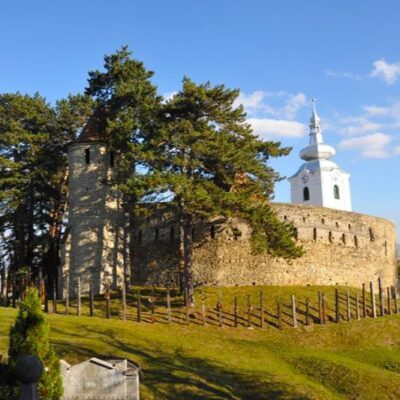Sfântu Gheorghe is a mountain which is home to several historical monuments and tourist objectives which help tourists get familiarised with the specific character of the area.
In the vicinity of the municipality, 8 km away, there is a spa resort – Șugaș-Băi – famous for its mineral waters, mofetic gases and treatments dedicated to people with heart disease. There is also ski slope in this resort. Although it is not a big city, Sfântu Gheorghe is an ideal tourist destination for relaxation.
This town has been inhabited since the Stone Age. The first documentary attestation in which the name of “Sfântu Gheorghe” was mentioned dates from the year 1332. However, it gained the status of a city officially in 1461.
The years 1651-1661 represented difficult times for the locals, who were the victims of the Tartars and Turks. During this period, the city was devastated.
Between 1848 and 1849, the inhabitants fought assiduously against the Austrian dominion, which brought suffering on all levels: social, military, and economic. This devastating period was overcome only in 1860, when a gradual process of development of the city began. Sfântu Gheorghe was the first city in the Szeklerland where there was a textile factory, the first in which a theatre operated and also the first beneficiary of electricity in the area.
After the First World War, the city came into the possession of the Romanian state, between 1940-1944 it became part of the Hungarian state, and after the Second World War, it became an integral part of Romania again.
Sfântu Gheorghe is the residence of the Covasna County and is located in the central area of Romania, in the Transylvania region. The city is located in the west of the county, on the banks of the Olt River, in the northern part of the Brașov depression. The depression in the Eastern Carpathians is located near the mountain groups: Baraolt, Bodoc, Brețcu, Buzău, Nemira and Vrancea. Its neighbours are to the north – Harghita, to the east – Bacău and Vrancea, to the west – Brașov, and to the south – Buzău.
The Fortified Reformed Church – this is the only medieval building that has stood the test of time, dating back to the 16th century. The church is located within the Citadel of Sfântu Gheorghe and is characterized by its Gothic architectural style. It was reconstructed in 1547 by its patron, Pál Daczó. Initially used as a shelter during Tatar attacks, the church was fortified with two rings of walls and defensive towers. The outer wall was demolished in 1786, and from its stone, the German school was built, at the command of Emperor Joseph II. The church has been affected by numerous earthquakes over time.
Inside, there are tombs of local personalities and an organ designed by Josef Angster, while the cemetery wall is surrounded by carved wooden funerary pillars, in memory of the deceased students and teachers of the Mikó Hungarian College.

It is declared a historical monument and was built in 1872. It is dedicated to Saint George and is located on Horia, Cloșca și Crișan Street – named after the three promoters of the 1784 peasant uprising, through which this social class fought to overcome its condition.
The original ensemble included a bell tower and a wooden church, built around 1810. In 1872, the current stone church was erected in place of the old one, which was in ruins. Nearby, the first Romanian Orthodox confessional school in Sfântu Gheorghe operated, which today serves as a memorial house.

Elisabeta Park – the origin of the name of this green space is not certain, but the two variants known nationally are related to two personalities, namely: Queen Elizabeth I of Romania and the Austrian Empress and Queen of Hungary of the same name, known as “Sissi”. This place is ideal for relaxing, walking and connecting with nature. In the vicinity of the park you will find tourist attractions such as: Unitarian Church, Saint Joseph Roman Catholic Church, the Arcade House, the Tamasi Aron Theatre as well as hotels, shops and restaurants.

The National Museum of the Eastern Carpathians – located on 16 Gabor Aron Street, this museum houses 15,000 objects from Harghita and Covasna counties such as: prehistoric remains, wooden pieces, peasant constructions, folk costumes, traditional tools, representative elements for the history of places.
Visiting hours: Tuesday – Friday: 10.00 – 16.00
Ticket price:
Adults: 6 lei
Pupils / students: 1.5 lei
Pensioners: 3 lei
Guided tour fee: 10 lei
Shooting fee: 5 lei
Filming fee: 10 lei
The museum organises various activities such as: puzzles, interactive videos, creative workshops. The fee for participating in workshops is 10 lei / person.

The Szekler National Museum – is an institution dedicated to science. Its purpose is to present to the general public some of the characteristic elements of the community in Szeklerland. We are talking about the existence of several internal sections in the following forms: Library, Department of Natural Sciences, Department of Archeology and History, Department of Ethnography. They are housed in a building located at 10 Kós Károly Street. This building is included in the list of museums of national importance.
Visiting hours:
Tuesday – Friday: 9:00 AM – 4:00 PM
Saturday – Sunday: 9:00 AM – 2:00 PM
Tickets:
Full-price ticket – 25 Lei
Reduced-price ticket (students, seniors) – 15 Lei
Group ticket for students and students (10-30 people) – 5 Lei / person

The nearest airport to Sfântu Gheorghe is Sibiu, 170 km away. The second closest is the one in Târgu-Mureș, located 190 km away.
From Sfântu Gheorghe Train Station there are daily trains that connect to the main Romanian cities: Bucharest, Brașov, Cluj-Napoca, Bacău.
To check the train schedule, access this site.
If you prefer to travel by bus / minibus, here you will find all the necessary information for this: bus stations and stops, departure and arrival times, destinations.
If you want to get from Bucharest to Sfântu Gheorghe by car, the distance you will have to travel is 215 km. The route you to take is: Bucharest – Ploiești – Sinaia – Brașov (A3) – Sfântu Gheorghe.

If you like music festivals, in Constanta you will find one to your taste, regardless of the style of music you prefer. Here you have a list with some of them, but you should know that every weekend there are events for all tastes.
diMANSIONS – Hit Music Festival Covasna – is a festival organised on the grounds of Miko Castle in Olteni (14 km away from St. George). The event takes place between 19 -21 June and brings to the fore the music of the 80s, 90s and 2000s that is promoted by various national and international artists. Thus, in a fairytale mountain setting, for three days, lovers of retro music can enjoy live music and magical parties.
What are you waiting for? Come and have a good time, enjoy music, nice people and magical places.